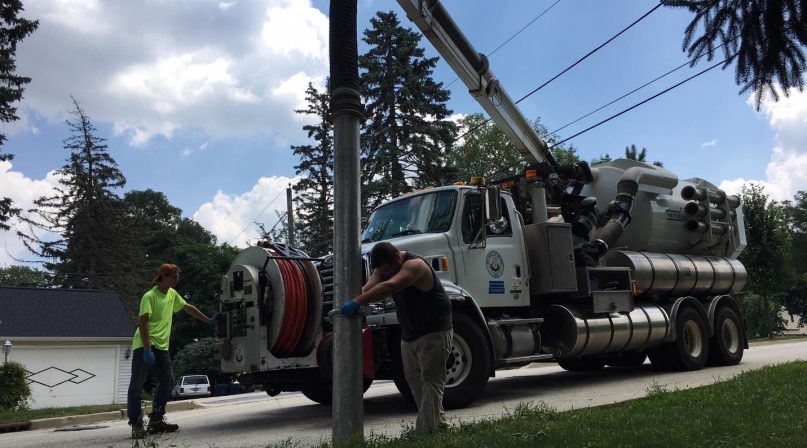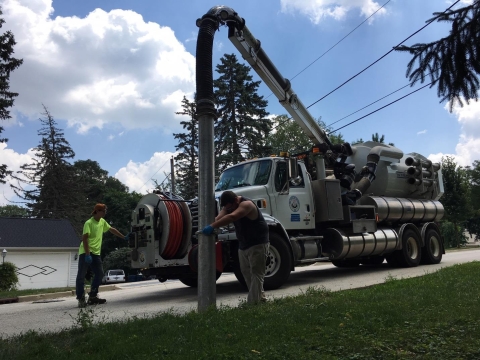Problem:
|
Government redundancies in stormwater maintenance and water quality complicate the process of complying with federal regulations for municipalities in DuPage County.
|
Solution:
|
Improve government efficiencies while improving water quality efforts through a shared services program.
|
A countywide water quality program is helping municipalities and townships improve stormwater management and save money — all through sharing services.
The DuPage County, Ill., Stormwater Management Department Shared Services Program helps municipalities and townships meet water quality and stormwater management goals. The countywide water quality program is the first of its kind in Illinois.
Through intergovernmental agreements (IGAs) with 41 municipalities and townships, the program saves local communities an estimated $1.56 million annually. Over nine months, all municipalities and townships signed on to the shared maintenance work.
Learn More
DuPage County’s Shared Services Program is the recipient of a 2019 NACo Achievement Award in the Community and Economic Development category.
The Environmental Protection Agency (EPA) has recognized the shared services program as a permit holder under the National Pollutant Discharge Elimination System (NPDES), which regulates pollution in municipal storm sewer systems. The EPA’s regulation served as the catalyst for the shared services program.
By only having to submit information to the EPA under one permit because of the IGAs, Jim Zay, chairman of the DuPage County Stormwater Management Planning Committee, said about $4.4 million is saved annually by working together on the program.
“Just the sheer repetitiveness of trying to comply with those federal regulations, it just seemed ridiculous as to how much money would get spent trying to do that on an individual, community-by-community, permit-by-permit basis,” said Anthony Charlton, director of Stormwater Management for the county.
The county had to get approval from the Illinois EPA to enter into a single NPDES permit, which the EPA signed off on, creating the countywide water quality program in May 2018.
The shared services program is mutually beneficial for the county and the municipalities. The shared maintenance work generated more than $300,000 in revenue for the Stormwater Management Department while simultaneously reducing the need for equipment and full-time staff for municipalities.
Zay said with budgets getting tighter, instead of municipalities and townships doing their own work, a central government can help to complete jobs.
“We’d do shared services at that point which would save not only municipalities and townships money but would also in the long run save the county a lot of money,” Zay said.
The county developed plans to assist municipalities and townships by inspecting watersheds, hosting countywide technical seminars and expanding public participation and education efforts involving storm drains.
Deputy Director of Stormwater Management Sarah Hunn explained that services also include removal of large blockages if there are stream obstructions, the use of tree chippers, dump trucks to remove material, the cleaning of storm sewers and mowing grass. The county allows communities to use county crews and equipment for scheduled and emergency maintenance. She added the department also has 11 engineers who can assist with work designs.
“Some of these smaller public works departments don’t have the crews and equipment that we have or have access to and we’re able to assist them by completing that work,” Hunn said.
She said the program is unique because it provides a variety of services to municipalities.
“Most communities, once they find out we’re helping them… they come in and surprisingly, both the communities and the residents are thanking their government which is not something that we hear about a lot,” she said.
Zay said the stormwater committee is made up of six county commissioners and six municipal representatives, providing leadership from both sides of government, making it easier to work on programs.
Charlton said the department is working on messaging to make it easier for residents to understand the shared services.
“Everyone is getting the benefit of a larger scale program than any individual municipality might be able to do, so it helps not just on the funding side of things, but our streams are cleaner and more efficient and the public is better educated by having this unified program,” Charlton said.
Zay emphasized that when it comes down to government, everyone is serving the same people and getting tax dollars from the same people, adding that it shouldn’t matter if a county crew or local municipality crew is working on a problem.
“It’s just breaking down that mindset and ultimately saving money and sharing services together,” Zay said.





